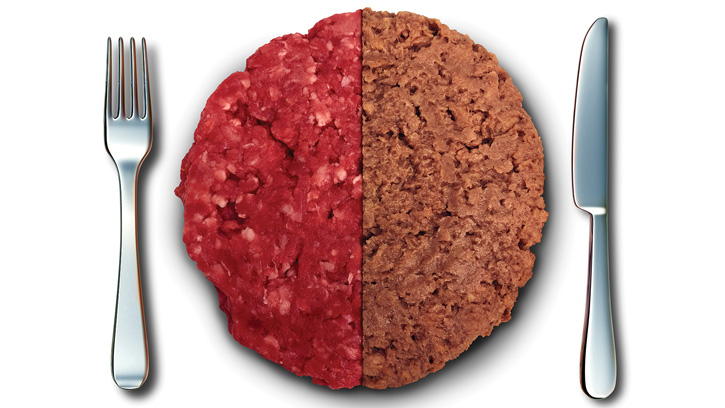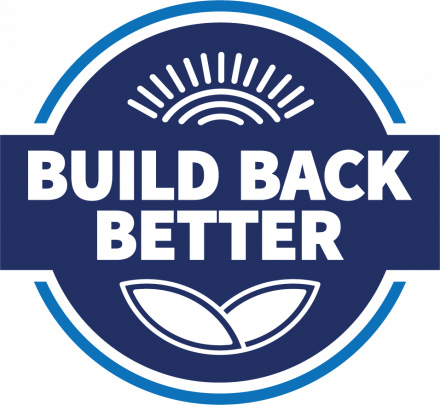Where’s the beef; Defeating botulism using math
NEWS
Where’s the beef?
When researchers at Kansas State University investigated whether plant-based meat alternatives could stack up against ground beef for taste and flavor, study participants responded with a resounding “no.” In fact, less than one-third of the respondents said they would purchase the alternatives in a retail setting.
“The results are pretty stark,” meat scientist Travis O’Quinn said in a press release. “Our three ground beef products were highly desired by consumers. We didn’t witness many differences among the three fat levels [10%, 20%, and 30%] we offered, but when we compared those to the ground beef alternatives, every one of the alternatives had a tendency to fall out (of favorability with consumers).”
Among the common observations made about the plant-based alternatives, which differed in taste and appearance as well as in how they were cooked, was that they were “extremely dry” and “very low” in flavor. Although the plant-based alternatives were found to be more tender than regular ground beef, the tenderness also made the products softer and less likely to hold together. In contrast, ground beef’s texture and ability to stick together were preferred by consumers.
Turning plastic waste into vanilla flavoring
A study published in Green Chemistry details how researchers at the University of Edinburgh used bacteria to transform plastic waste into vanillin. The scientists say the flavoring would be fit for human consumption, although further tests would be required.
Using the common bacteria E. coli, the scientists transformed terephthalic acid—a molecule derived from polyethylene terephthalate (PET)—into vanillin via a series of chemical reactions. The team demonstrated the technique by adding E. coli to degraded waste from a plastic bottle and converting it into vanillin. The technique lays the foundation for further exploration of ways to produce vanillin at industrially relevant levels.
The world’s plastic crisis has seen an urgent need to develop new methods to recycle PET, which is widely used for packaging foods and beverages. Approximately 50 million tons of PET waste is produced annually, seriously impacting the environment. Although it is possible to recycle PET, current methods produce products that also contribute to plastic pollution worldwide.
First author Joanna Sadler commented in a press release, “This is the first example of using a biological system to upcycle plastic waste into a valuable industrial chemical, and this has very exciting implications for the circular economy.
“The results from our research have major implications for the field of plastic sustainability and demonstrate the power of synthetic biology to address real-world challenges.”
Defeating botulism using math
Researchers at the National Food Institute have developed a mathematical model to predict whether a particular recipe for chilled products can prevent the growth of Clostridium botulinum and production of the toxin that causes botulism. The scientists’ work is described in an article in the International Journal of Food Microbiology.
Currently, producers of lightly preserved, ready-to-eat food must conform to a set of guidelines to stop the growth of Clostridium botulinum bacteria. For refrigerated products, water contained in the products must have a salt content of at least 3.5%, a level that hampers efforts to develop salt-reduced products. If food producers want less salt in their product, they must conduct time-consuming laboratory experiments to document that the recipe change will not compromise food safety. The new technique replaces the costly laboratory experiments.
The model is the most comprehensive of its kind, indicating how storage temperature, pH, salt, and the use of five different preservatives affect potential bacterial growth and production of the toxin. Originally developed for use in fish products, the technique has been established as effective in assessing the safety of recipes for both fish and poultry. Future research on the model will include foods such as meat and vegetable products.
Specialty food market reaches $170.4 billion in sales
From 2018 to 2020, the specialty food market experienced a 13% increase in total sales, reaching $170.4 billion, according to the annual State of the Specialty Food Industry Report from The Specialty Food Association.
Retail dollar sales were led by frozen and refrigerated meat, poultry, and seafood followed by cheese and plant-based cheese; chips, pretzels, and snacks; bread and baked goods; and non-ready-to-drink coffee and hot cocoa. The seasonings category led in fastest growth, followed by shelf-stable sauces, pasta, and pizza; shelf-stable beans, grains, and dry rice; frozen fruit and vegetables; and refrigerated creams and creamers.
Among the overall trends the survey revealed were the rebirth of the center store; the need to improve innovation discovery; the challenge of competing with online shopping for visibility; increased competition from the plant-based specialty food and beverage market, which grew 42%; and channel shifting, which resulted in phenomenal growth for online e-grocery markets.
USDA’s investment in the food system
The U.S. Department of Agriculture (USDA) plans to invest more than $4 billion to strengthen critical supply chains through the Build Back Better initiative. The effort is designed to fortify the food system, create new market opportunities, tackle the climate crisis, help communities that have been left behind, and support well-paying jobs throughout the supply chain.
Funding will include a mix of grants, loans, and innovative financing mechanisms to support four critical priorities:
• Food Production. Through a combination of direct assistance, grants, training, and technical assistance, USDA will invest in food producers and workers in the food system.
• Food Processing. During the pandemic, supply bottlenecks led to a drop in plant and slaughter capacity and affected the ability of small and midsize farmers to compete for processing access. To address challenges related to consolidated processing capacity, USDA investments will support new and expanded regional processing capacity.
• Food Distribution and Aggregation. Due to long shipping distances and lack of investment in local and regional capacity, the food aggregation and distribution system was stressed during the pandemic. To help remedy the situation, investments will be made in initiatives that help ensure a resilient, flexible, and responsive food system.
• Markets and Consumers. The United States has higher rates of diet-related illness and a lower life expectancy than other nations. At the same time, many socially disadvantaged and small and midsized producers do not have equitable access to markets. USDA has committed to supporting and expanding market access for a diversity of growers while helping consumers access healthy foods.
In addressing the scope of the Build Back Better initiative, Agriculture Secretary Tom Vilsack commented in a press release, “The COVID-19 pandemic led to massive disruption for growers and food workers. It exposed a food system that was rigid, consolidated, and fragile. Meanwhile, those growing, processing, and preparing our food are earning less each year in a system that rewards size over all else. The Build Back Better initiative will make meaningful investments to build a food system that is more resilient against shocks, delivers greater value to growers and workers, and offers consumers an affordable selection of healthy food produced and sourced locally and regionally by farmers and processors from diverse backgrounds.






